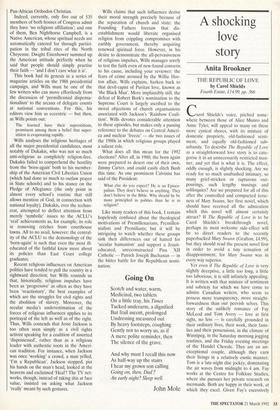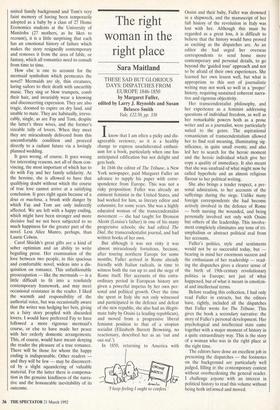A shocking love story
Anita Brookner
THE REPUBLIC OF LOVE by Carol Shields Fourth Estate, £14.99, pp. 366
• ■•
Carol Shields's voice, pitched some- where between those of Alice Munro and Anne Tyler, will appeal to many on these more cynical shores, with its mixture of domestic propriety, old-fashioned senti- ment, and equally old-fashioned sub- urbanity. To describe The Republic of Love as a straightforward love story is to cate- gorise it in an unnecessarily restricted man- ner, and yet that is what it is. The effect, oddly enough, is slightly shocking. Are we ready for so much unabashed intimacy, so many grief-stricken or rapturous out- pourings, such lengthy musings and soliloquies? Are we prepared for all of this after the controlled and compacted terse- ness of Mary Swann, her first novel, which should have received all the admiration which this novel will almost certainly attract? If The Republic of Love is to be Carol Shields's breakthrough novel, perhaps its most welcome side-effect will be to direct readers to the recently paperbacked Mary Swann (Grafton, £4.99), but they should read the present novel first in order to avoid a tiny sensation of disappointment, for Mary Swann was in every way superior.
Yet even if The Republic of Love is very slightly deceptive, a little too long, a little too laborious, it is still infinitely appealing. It is written with that mixture of sentiment and sobriety for which we have come to admire Canadian writers, who seem to possess more transparency, more straight- forwardness than our peevish selves. This story of the unlikely romance of Fay McLeod and Tom Avery — love at first sight, no less — is carefully grounded in their ordinary lives, their work, their fami- lies and their possessions, in the climate of Winnipeg, in the Saturday morning jogging routines, and the Friday evening meetings of the Handel Chorale. They are an un- exceptional couple, although they earn their livings in a relatively exotic manner. Tom is a late-night disc jockey, dominating the air waves from midnight to 4 am. Fay works at the Centre for Folklore Studies. where she pursues her private research on mermaids. Both are happy in their work, at which they excel. Given Fay's excessively
united family background and Tom's very faint memory of having been temporarily adopted as a baby by a class of 27 Home Economics students at the University of Manitoba (27 mothers, as he likes to recount), it is a little surprising that each has an emotional history of failure which makes the story resignedly contemporary and removes it from the area of fable, or fantasy, which all romantics need to consult from time to time.
How else is one .to account for the mermaid symbolism which permeates the
novel? Mermaids are sly, thin creatures, luring sailors to their death with unearthly music. They sing or blow trumpets, comb their hair, and invariably wear a knowing and disconcerting expression. They are also tragic, doomed to expire on dry land, and unable to mate. They are habitually, irrevo- cably, single, as are Fay and Tom, despite the latter's three wives, and the former's sizeable tally of lovers. When they meet they are miraculously delivered from this uncomfortable condition and proceed directly to a radiant future via a lovingly planned wedding.
It goes wrong, of course. It goes wrong for interesting reasons, not all of them con- vincing, the most important of which has to do with Fay and her family solidarity. As the heroine, she is allowed to have that qualifying doubt without which the course of true love cannot arrive at a satisfying conclusion. It goes right again because of a
dens ex machina, a brush with danger by
which Fay and Tom are only indirectly affected. We are left with a happy ending, which might have been stronger and more decisive had we not been subjected to so much happiness for the greater part of the novel. Less Alice Munro, perhaps, than Laurie Colwin.
Carol Shields's great gifts are a kind of sober optimism and an ability to write beguiling prose. Her examination of the love between two people, in this spacious and comfortable novel, widens into a dis- quisition on romance. This unfashionable preoccupation — like the mermaids — is a little difficult to fit into a resolutely contemporary framework, and may meet occasional resistance in the reader. I liked the warmth and responsibility of the authorial voice, but was occasionally aware that the writer was hedging her bets, giving us a fairy story peopled with discarded lovers. I would have preferred Fay to have followed a more rigorous mermaid's course, or else to have made her peace with her orderly domestic arrangements.
This, of course, would have meant denying the reader the pleasure of a true romance.
There will be those for whom the happy ending is indispensable. Other readers and they will be few — may be disconcert- ed by a slight squandering of valuable material. For the latter there is compensa- tion in the genuine kindliness of the narra- tive and the honourable inevitability of its outcome.



























































 Previous page
Previous page